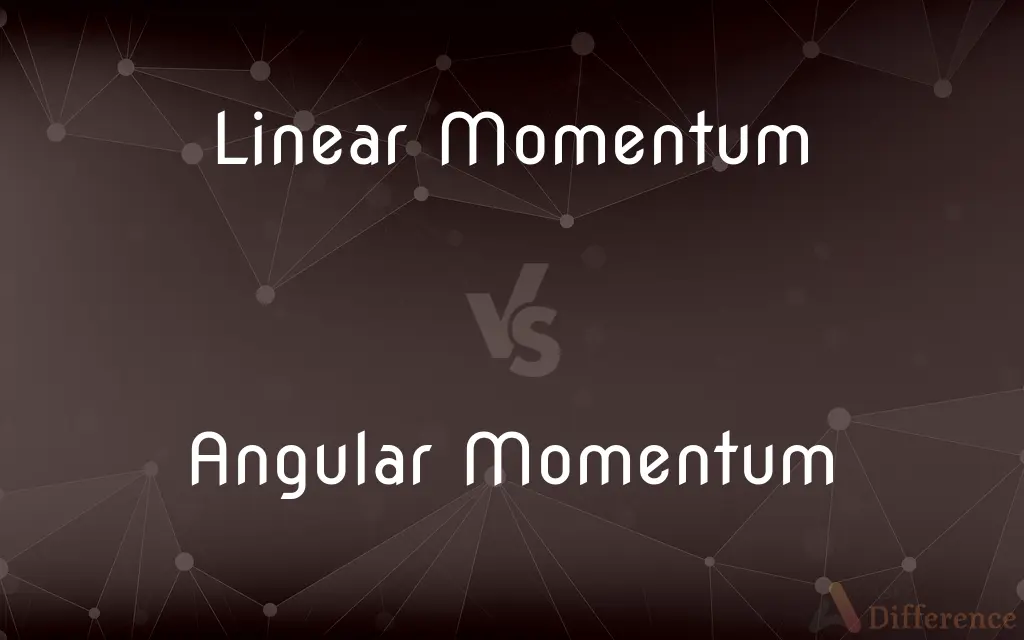Linear Momentum vs. Angular Momentum — What's the Difference?
By Tayyaba Rehman — Published on October 15, 2023
Linear Momentum pertains to motion in a straight line and is the product of mass and velocity, while Angular Momentum relates to rotational motion and is the product of moment of inertia and angular velocity.

Difference Between Linear Momentum and Angular Momentum
Table of Contents
ADVERTISEMENT
Key Differences
Linear Momentum and Angular Momentum are foundational concepts in the realm of physics. Linear Momentum, often simply referred to as momentum, is a measure of an object's motion in a straight line. It is quantified as the product of the object's mass and its linear velocity. Angular Momentum, conversely, relates to the rotation of an object around a point or an axis. This is described as the product of the object's moment of inertia and its angular velocity.
In practical terms, Linear Momentum can be visualized when a hockey player shoots a puck; the puck's motion on the ice represents its linear momentum. In contrast, Angular Momentum can be seen in a figure skater's spin; as the skater pulls in their arms, their spin becomes faster due to the conservation of angular momentum.
While both Linear Momentum and Angular Momentum are conserved quantities in physics, their implications differ. The conservation of Linear Momentum is evident in collisions when the total momentum before the collision equals the total momentum after. Angular Momentum conservation is showcased when a rotating object continues to rotate until an external torque acts on it.
It's crucial to distinguish between these types of momentum in different scenarios. For instance, in space, a planet orbits a star not because of its linear momentum but due to its angular momentum, which remains constant in the absence of external torques. Simultaneously, Linear Momentum is often a consideration in ground-based scenarios, like car crashes or sports.
Comparison Chart
Definition
Product of mass and linear velocity
Product of moment of inertia and angular velocity
ADVERTISEMENT
Relates to
Straight-line motion
Rotational motion
Conservation in
Collisions
Absence of external torque
Example
Hockey puck's motion on ice
Figure skater's spin
Associated with
Mass
Moment of inertia
Compare with Definitions
Linear Momentum
Linear Momentum can change with force.
By applying a force, she changed the linear momentum of the sled.
Angular Momentum
Angular Momentum changes with external torques.
The gymnast used her arms to change her angular momentum during the flip.
Linear Momentum
Conservation of Linear Momentum occurs in collisions.
The cars exchanged linear momentum during the crash.
Angular Momentum
Angular Momentum has a directional component.
The wheel's angular momentum was oriented around its central axis.
Linear Momentum
Linear Momentum has direction and magnitude.
The linear momentum of the arrow pointed directly at the target.
Angular Momentum
Angular Momentum is tied to moment of inertia.
The dancer's angular momentum increased as she reduced her moment of inertia by pulling her arms in.
Linear Momentum
Linear Momentum is mass in motion.
The football, when kicked, gained significant linear momentum.
Angular Momentum
Conservation of Angular Momentum explains consistent rotation.
The spinning top preserved its angular momentum until it was disturbed.
Linear Momentum
Linear Momentum is the product of mass and velocity.
A truck moving at a high speed has greater linear momentum than a bicycle at the same speed.
Angular Momentum
Angular Momentum concerns rotational motion.
Earth maintains its orbit due to its angular momentum.
Common Curiosities
How is Linear Momentum calculated?
Linear Momentum is calculated as the product of mass and linear velocity.
Is Linear Momentum always conserved?
In the absence of external forces, Linear Momentum is conserved.
Do Linear Momentum and Angular Momentum measure the same thing?
No, Linear Momentum measures straight-line motion, while Angular Momentum measures rotational motion.
How does the conservation of Angular Momentum apply to figure skaters?
Skaters spin faster when they reduce their moment of inertia by pulling in their arms, conserving Angular Momentum.
How does force relate to Linear Momentum?
A force can change an object's Linear Momentum.
Why is Angular Momentum crucial for celestial bodies?
Celestial bodies like planets maintain their orbits due to the conservation of Angular Momentum.
What factors affect Angular Momentum?
Angular Momentum is influenced by the moment of inertia and angular velocity.
What units are used for Linear Momentum?
Linear Momentum is measured in kilogram-meters per second (kg.m/s).
Can an object have both Linear Momentum and Angular Momentum simultaneously?
Yes, an object can possess both types of momentum, like a rolling ball.
How does torque relate to Angular Momentum?
A torque can change an object's Angular Momentum.
Share Your Discovery

Previous Comparison
Green Berets vs. Navy SEALs
Next Comparison
Gross Primary Productivity vs. Net Primary ProductivityAuthor Spotlight
Written by
Tayyaba RehmanTayyaba Rehman is a distinguished writer, currently serving as a primary contributor to askdifference.com. As a researcher in semantics and etymology, Tayyaba's passion for the complexity of languages and their distinctions has found a perfect home on the platform. Tayyaba delves into the intricacies of language, distinguishing between commonly confused words and phrases, thereby providing clarity for readers worldwide.














































